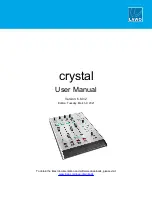
a whole network of marine electronics from any
manufacturer to communicate on a common bus via
standardized message types and formats.
SeaTalk
SeaTalk is a protocol which enables compatible
instruments to connect to each other and share data.
The SeaTalk cable system is used to connect
compatible instruments and equipment. The cable
carries power and data and enables connection
without the need for a central processor.
Additional instruments and functions can be added to
a SeaTalk system, simply by plugging them into the
network. SeaTalk equipment can also communicate
with other non-SeaTalk equipment via the NMEA
0183 standard, provided a suitable interface is used.
NMEA 0183
The NMEA 0183 Data Interface Standard was
developed by the National Marine Electronics
Association of America. It is an international
standard to enable equipment from many different
manufacturers to be connected together and share
information.
The NMEA 0183 standard carries similar information
to SeaTalk. However it has the important difference
that one cable will only carry information in one
direction. For this reason NMEA 0183 is generally
used to connect a data receiver and a transmitter
together, e.g. a compass sensor transmitting
heading to a radar display. This information is
passed in ‘sentences’, each of which has a three
letter sentence identifier. It is therefore important
when checking compatibility between items that the
same sentence identifiers are used some examples
of which are:
•
VTG - carries Course and Speed Over Ground
data.
•
GLL - carries latitude and longitude.
•
DBT - carries water depth.
• MWV - carries relative wind angle and wind speed
data.
NMEA Baud rates
The NMEA 0183 standard operates at a number
of different speeds, depending upon the particular
requirement or equipment capabilities. Typical
examples are:
• 4800 baud rate. Used for general purpose
communications, including FastHeading data.
• 38400 baud rate. Used for AIS and other high
speed applications.
3.7 Data master
Any system containing more than one networked
multifunction display must have a designated data
master.
The data master is the display which serves as a
primary source of data for all displays, it also handles
all external sources of information. For example
the displays may require heading information from
the autopilot and GPS systems, usually received
through a SeaTalk
ng
or NMEA connection. The data
master is the display to which the SeaTalk, NMEA
and any other data connections are made, it then
bridges the data to the SeaTalk
hs
network and any
compatible repeat displays. Information shared by
the data master includes:
• Cartography
• Routes and waypoints
• Radar
• Sonar
• Data received from the autopilot, instruments, the
engine and other external sources.
Your system may be wired for redundancy with data
connections made to repeat displays. However these
connections will only become active in the event of a
fault and/or reassignment of the data master.
In an autopilot system which does not contain a
dedicated pilot control head the Data master also
acts as the control for the autopilot.
Planning the installation
27
Summary of Contents for E-Series
Page 2: ......
Page 4: ......
Page 34: ...34 a Series c Series e Series installation instructions...
Page 86: ...86 a Series c Series e Series installation instructions...
Page 100: ...100 a Series c Series e Series installation instructions...
Page 111: ......
















































